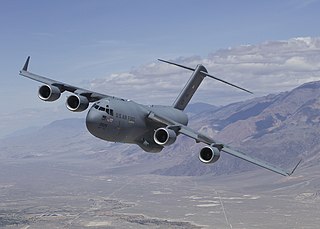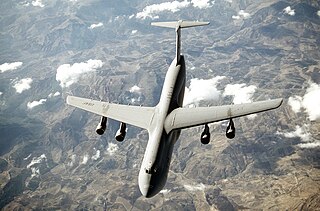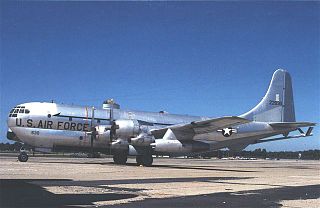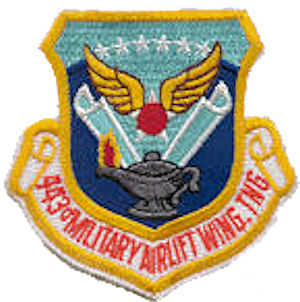
The McDonnell Douglas/Boeing C-17 Globemaster III is a large military transport aircraft that was developed for the United States Air Force (USAF) from the 1980s to the early 1990s by McDonnell Douglas. The C-17 carries forward the name of two previous piston-engined military cargo aircraft, the Douglas C-74 Globemaster and the Douglas C-124 Globemaster II.

McChord Field is a United States Air Force base in the northwest United States, in Pierce County, Washington. South of Tacoma, McChord AFB is the home of the 62d Airlift Wing, Air Mobility Command, the airbase’s primary mission being worldwide strategic airlift.

The Lockheed C-5 Galaxy is a large military transport aircraft designed and built by Lockheed, and now maintained and upgraded by its successor, Lockheed Martin. It provides the United States Air Force (USAF) with a heavy intercontinental-range strategic airlift capability, one that can carry outsized and oversized loads, including all air-certifiable cargo. The Galaxy has many similarities to the smaller Lockheed C-141 Starlifter and the later Boeing C-17 Globemaster III. The C-5 is among the largest military aircraft in the world.

The Douglas C-133 Cargomaster is an American large turboprop cargo aircraft built between 1956 and 1961 by the Douglas Aircraft Company for use with the United States Air Force. The C-133 was the USAF's only production turboprop-powered strategic airlifter, entering service shortly after the Lockheed C-130 Hercules, which is designated a tactical airlifter. It provided airlift services in a wide range of applications, being replaced by the C-5 Galaxy in the early 1970s.

The Boeing C-97 Stratofreighter was a long-range heavy military cargo aircraft developed from the B-29 and B-50 bombers. Design work began in 1942, the first of three prototype XC-97s flew on 9 November 1944, and the first of six service-test YC-97s flew on 11 March 1947. All nine were based on the 24ST alloy structure and Wright R-3350 engines of the B-29, but with a larger-diameter fuselage upper lobe and they had the B-29 vertical tail with the gunner's position blanked off. The first of three heavily revised YC-97A incorporating the re-engineered wing, taller vertical tail and larger Pratt & Whitney R-4360 engines of the B-50 bomber, flew on 28 January 1948 and was the basis of the subsequent sole YC-97B, all production C-97s, KC-97s and civilian Stratocruiser aircraft. Between 1944 and 1958, 888 C-97s in several versions were built, 811 being KC-97 tankers. C-97s served in the Berlin Airlift, the Korean War, and the Vietnam War. Some aircraft served as flying command posts for the Strategic Air Command, while others were modified for use in Aerospace Rescue and Recovery Squadrons (ARRS).

The Douglas C-74 Globemaster was a United States heavy-lift cargo aircraft built by the Douglas Aircraft Company in Long Beach, California. The aircraft was developed after the Japanese attack on Pearl Harbor. The long distances across the Atlantic and, especially, Pacific oceans to combat areas indicated a need for a transoceanic heavy-lift military transport aircraft. Douglas Aircraft Company responded in 1942 with a giant four-engined design. Development and production modifications issues with the aircraft caused the first flight to be delayed until 5 September 1945, and production was limited to 14 aircraft when the production contract was canceled following V-J Day.

The Lockheed C-141 Starlifter is a retired military strategic airlifter that served with the Military Air Transport Service (MATS), its successor organization the Military Airlift Command (MAC), and finally the Air Mobility Command (AMC) of the United States Air Force (USAF). The aircraft also served with airlift and air mobility wings of the Air Force Reserve (AFRES), later renamed Air Force Reserve Command (AFRC), the Air National Guard (ANG) and, later, one air mobility wing of the Air Education and Training Command (AETC) dedicated to C-141, C-5, C-17 and KC-135 training.

The Boeing KC-97 Stratofreighter is a four-engined, piston-powered United States strategic tanker aircraft based on the Boeing C-97 Stratofreighter. It replaced the KB-29 and was succeeded by the Boeing KC-135 Stratotanker.

The Military Air Transport Service (MATS) is an inactive Department of Defense Unified Command. Activated on 1 June 1948, MATS was a consolidation of the United States Navy's Naval Air Transport Service (NATS) and the United States Air Force's Air Transport Command (ATC) into a single joint command. It was inactivated and discontinued on 8 January 1966, superseded by the Air Force's Military Airlift Command (MAC) as a separate strategic airlift command, and it returned shore-based Navy cargo aircraft to Navy control as operational support airlift (OSA) aircraft.

The 443d Airlift Wing is an inactive unit of the United States Air Force. Its last assignment was with Air Mobility Command, being stationed at Altus Air Force Base, Oklahoma. It was inactivated on October 1, 1992.

The 183rd Airlift Squadron is a unit of the 172nd Airlift Wing of the Mississippi Air National Guard, stationed at Allen C. Thompson Field Air National Guard Base, Mississippi. If activated to federal service, the Wing is gained by the United States Air Force Air Mobility Command.

The 62d Operations Group is a United States Air Force unit assigned to the 62d Airlift Wing. It is stationed at McChord Air Force Base, Joint Base Lewis-McChord, Washington.

The 1705th Air Transport Group is an inactive United States Air Force unit. Its last was assigned to the Western Transport Air Force, Military Air Transport Service, stationed at McChord Air Force Base, Washington. It was inactivated on 18 June 1960. Upon inactivation, most personnel and equipment reassigned to 62d Air Transport Wing.

The 40th Military Airlift Squadron is an inactive United States Air Force unit. Its last assignment was to the 438th Military Airlift Wing, Military Airlift Command, stationed at McGuire Air Force Base, New Jersey.

The 937th Training Group is a United States Air Force unit stationed at Fort Sam Houston, part of Joint Base San Antonio, Texas. It conducts medical training for the Air Force.

The 941st Military Airlift Group is an inactive United States Air Force Reserve unit. It was last active with the 349th Military Airlift Wing, based at McChord AFB, Washington. It was inactivated on 25 July 1969.

The 942nd Military Airlift Group is an inactive United States Air Force Reserve unit. It was last active with the 452nd Military Airlift Wing, based at Norton AFB, California. It was inactivated on 1 January 1972.

The Tachikawa air disaster occurred on the afternoon of Thursday, June 18, 1953, when a United States Air Force (USAF) Douglas C-124 Globemaster II aircraft crashed three minutes after takeoff from Tachikawa, Japan, killing all 129 people on board. At the time, the crash was the deadliest in aviation history.

The 1952 Moses Lake C-124 crash was an accident in which a United States Air Force Douglas C-124 Globemaster II military transport aircraft crashed near Moses Lake, Washington on December 20, 1952. Of the 115 people on board, 87 died and 28 survived. The crash was the world's deadliest aviation disaster at the time, surpassing the Llandow air disaster, which killed 80 people. The death toll would not be surpassed until the Tachikawa air disaster, which also involved a Douglas C-124A-DL Globemaster II, killed 129 people.

Travis Air Force Base is a United States Air Force base under the operational control of Air Mobility Command (AMC), located three miles east of the central business district of the city of Fairfield, in Solano County, California, United States.




























